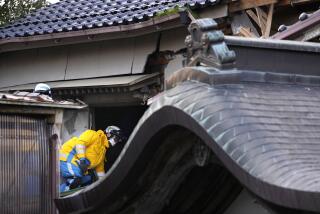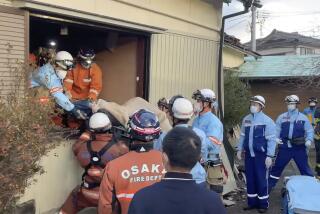DEVASTATING JOLT IN JAPAN : U.S. Officials Deal With Aftermath : Search: Consulate staffers try to track down Americans. So far, 763 of an estimated 8,000 in area are confirmed safe.
- Share via
TOKYO — The father of one of the Japanese students who was being taught by Voni Lynn Wong did not know the Van Nuys woman who had worked as an English teacher in the town of Ashiya.
But Tuesday, when Wong’s home collapsed and made her the first known American fatality of Japan’s disastrous earthquake, the student’s father pulled Wong’s body from the wreckage and stayed with the remains all day until Japanese officials released the body to U.S. consular officers.
The man--his name was not known--had lost his own home in the quake.
Wayne Griffith, consul general at the U.S. Embassy in Tokyo, told that anecdote Friday as he discussed how the U.S. Embassy in Tokyo and the consulate general in Osaka dealt with the aftermath of Japan’s worst earthquake since 1923. By early today, the death toll exceeded 4,600.
Wong, 24, was one of two Americans confirmed dead. The name of the second, also an English teacher who died when her Kobe home collapsed on her, has not been disclosed. Two other Americans are known to be injured but are not hospitalized, Griffith added.
Griffith said the 10 American staffers at the Osaka consulate general, now bolstered by a reinforcement of 10 officials from the embassy in Tokyo, had confirmed the safety of 763 of an estimated 8,000 Americans who live and work in the Kobe-Osaka area.
“The disparity between the number we have contacted and the estimated number of residents is worrisome. But we do not anticipate any great number of fatalities emerging, because the greatest damage occurred in places where Americans don’t live,” Griffith said.
U.S. Ambassador Walter F. Mondale ordered non-consular officials at the Osaka consulate to put aside their normal responsibilities in such fields as agriculture and commerce and devote themselves to confirming the safety of U.S. citizens. Mondale also transferred to Tokyo all of the Osaka consulate’s work of issuing visas to Japanese going to the United States, Griffith said.
In Washington, the State Department set up a working group (phone number 202-647-0900) to take requests from U.S. residents for information about friends or relatives in Japan. Embassy officers have driven or hitchhiked to Kobe and visited hospitals, police stations and relief centers in their search for Americans, Griffith said. The work has been complicated by the fact that “the great majority of Americans living in Japan never register with the embassy or the consulate,” he said.
Since Tuesday, registrations have increased, he added.
*
Many Americans are moving out of Kobe--most to other cities nearby, Griffith said. On Thursday, Procter & Gamble evacuated staff members by boat from its Japanese headquarters located on Rokko Island off Kobe, setting up temporary operations in Osaka.
None of the Americans at the Osaka consulate was injured in the earthquake, Griffith said. But the residence of Consul General David Pabst in Nishinomiya and the 11-story consulate near the Umeda section of downtown Osaka suffered damage.
At the consulate, two chimneys and a wall collapsed; there was no structural damage. Plumbing was destroyed in Pabst’s residence, making the building, designated as a historically significant structure by the city of Nishinomiya, unsuitable for use.
Pabst has moved into a compound in Nishinomiya in which the homes of nine other consular staffers are located, Griffith said.
More to Read
Sign up for Essential California
The most important California stories and recommendations in your inbox every morning.
You may occasionally receive promotional content from the Los Angeles Times.













